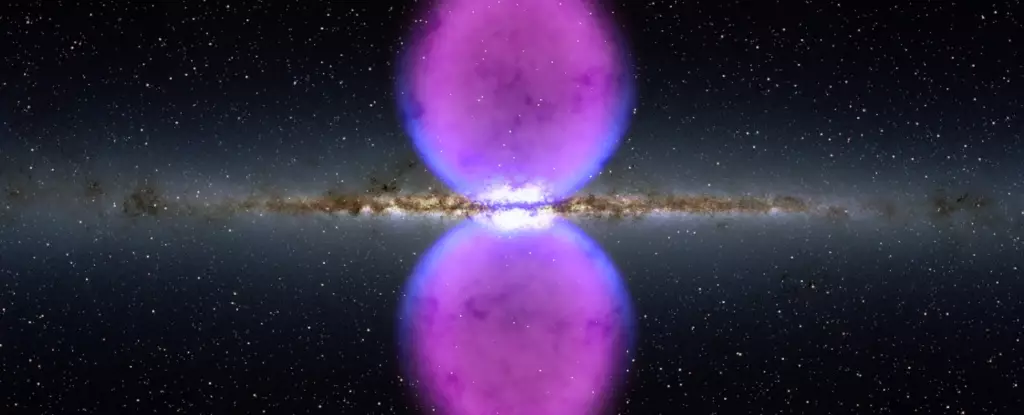In the vast and tumultuous realm of our galaxy, recent findings challenge long-held assumptions about the extreme environments surrounding the Milky Way. Astronomers have identified unexpectedly cold hydrogen clouds nestled within the blazing fury of the Fermi Bubbles—gigantic lobes of energetic gas that stretch tens of thousands of light-years above and below the galactic plane. This discovery is nothing short of revolutionary, forcing scientists to reconsider the intricate dance of matter and energy in galaxies. Rather than remaining confined to tranquil cosmic corners, the existence of these icy pockets in such a hostile setting suggests a resilience and complexity previously unimagined.
The Fermi Bubbles, first illuminated by data from the Fermi Gamma-Ray Space Telescope in 2010, have intrigued scientists with their explosive origin and immense scale. These structures are believed to have formed from powerful outbursts emanating from the supermassive black hole at the Milky Way’s core. Their turbulent environment—characterized by plasma temperatures soaring to around one million Kelvin—should theoretically obliterate fragile cold gas. Yet, remarkably, recent radio surveys utilizing the Green Bank Telescope have unveiled the presence of neutral hydrogen clouds, some spanning nearly a hundred light-years, maintaining relatively chilly temperatures of about 10,000 Kelvin. Such a stark temperature contrast is akin to finding icy chunks in the heart of a volcano—a metaphor that betrays the surprising tenacity of these clouds.
This observation disrupts our conventional understanding that high-energy galactic outflows would disperse or vaporize cold gas almost instantaneously. Instead, the data point towards a complex lifecycle for these clouds, hinting at an underlying stability amid chaos. Their presence suggests that the processes governing galactic matter recycling are far more nuanced than previously believed. It prompts an urgent reevaluation of how cold gas survives, condenses, and is transported through energetic galactic winds. As astrophysicist Rongmon Bordoloi articulates, “The survival of these frigid clouds in such a hot environment defies our basic assumptions, posing questions about the capacity of galaxies to recycle and maintain cold gas in turbulent conditions.”
The clouds’ dimensions and inferred ages further deepen the mystery. The biggest reported clouds contain masses equivalent to thousands of suns and have traversed distances of up to 13,000 light-years above the galaxy’s center. When their age estimates—on the order of a few million years—are juxtaposed with the estimated age of the Fermi Bubbles themselves, a coherent narrative begins to emerge. These clouds may have been lofted upward by the galaxy’s nuclear wind—a powerful, high-velocity plasma stream emanating from the core. This wind acts as a conveyor belt, carrying matter from the galactic nucleus to the halo, shaping the galaxy’s evolution in profound ways.
Understanding this process is not merely academic; it serves as a crucial puzzle piece in the larger picture of galactic life cycles. The clouds essentially serve as tracers, revealing the otherwise invisible motion of fast-moving winds. As Jay Lockman from the Green Bank Observatory emphasizes, “Without these cold clouds acting as signposts, we would have no direct way to observe or measure the otherwise elusive galactic wind.” Their existence provides vital clues about the dynamics of energy transfer, matter recycling, and the interplay between different phases of gas within galaxies.
From a temporal perspective, these hydrogen clouds are ephemeral in the grand scheme—lasting only a few million years—yet their transient nature offers invaluable insights. They may have originated from larger molecular structures that fragmented under intense plasma interactions, or alternatively, condensed locally due to thermal instabilities in the hot gas. Both scenarios underscore the dynamic and tumultuous conditions at play, emphasizing that galactic environments are far from uniform or static.
The implications of this discovery ripple outward, touching on universal themes of galaxy formation and evolution. If cold gas can endure in such hostile scenarios within the Milky Way, it suggests that similar processes might occur in other galaxies, especially those with active nuclei and energetic outflows. This revelation invites a reinterpretation of models that explain how galaxies grow, shed, and recycle their matter, potentially leading to a paradigm shift in our understanding of cosmic architecture.
In essence, these newfound hydrogen clouds symbolize resilience in the face of galactic chaos. Their existence pushes boundaries and compels astrophysicists to unravel more about the unseen forces that shape the universe. As we refine our tools and gaze deeper into these phenomena, it becomes increasingly clear that the universe is more adaptive and intricate than the simplified models we have relied on. These icy enclaves amid blazing plasma not only redefine our comprehension of the Milky Way but also ignite curiosity about the boundless adaptability of matter across the cosmos.


Leave a Reply